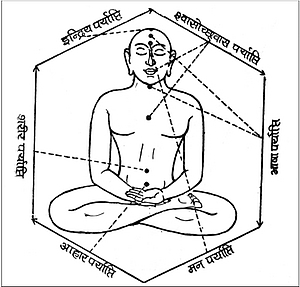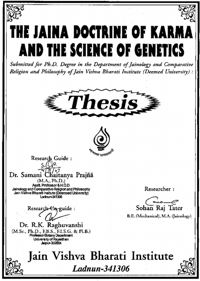 Jaina biology states that the fabric of life of all the plants and animals is paryāpti (śakti = vital force)[76] or prāṇa (life force) in another way. That is paryāpti appears to be actual living material of all plants and animals. There are stated six kinds of paryāpti[77] viz.
Jaina biology states that the fabric of life of all the plants and animals is paryāpti (śakti = vital force)[76] or prāṇa (life force) in another way. That is paryāpti appears to be actual living material of all plants and animals. There are stated six kinds of paryāpti[77] viz.
- Āhāra paryāpti
Vital force by which a living being takes, digests, absorbs and transforms molecules of food particles into (waste products) khala and rasa chyl-molecules of nutrients or energy).[78]
- Śarīra paryāpti
Vital force by which chyle or molecules of nutrients are utilized by beings for the release of energy, the building of blood, tissue, fat, bone, merrow, semen etc.[79]
- Indriya paryāpti
Vital force by which molecules of nutrients or chyles suitable for building senses are taken in and provided to the proper place so that beings can have perceptual knowledge of desired sense-objects by the same organs.[80]
- Ucchvāsa prayāpti
Vital force by which particles of respiration are taken in, oxidized for energy and left out as carbon-di-oxide and water.[81]
- Bhāṣā paryāpti
Vital force by which beings having taken proper particles of speech, emit them as speech.[82]
- Manaḥ paryāpti
Vital force by which beings having taken particles (or ducts) of mind transform them by the mental process and give vent to them as the mental force i.e. thought.[83] It appears that this paryāpti (vital force) is not a single substance but varies considerably from organism to organism (i.e. one sensed to five sensed beings) among the various parts of a single animal or plant, and from one time to another the gaining of the capacities starts simultaneously, but the completion of each of them is effected gradually with in the period of one antarmuhūrta, which increases in the case of each succeeding one. Yet their total period does not exceed one antarmuhūrta[84] with in a single organ or part of an animal or plant. There are six paryāptis, but they share certain fundamental physical and chemical characteristics.[85]
Pajjati = paryāpti, Navatatva prakaraṇa, v. 6; Dharmavijaya, p. 12; Gommatasāra Jivakāṇda v.v. 118-119; Lokaprakāśa, Vinayavijaya, part-I, 3rd sarga, v.v. 15ff.
Lokaprakāśa Vinayavijaya pt. I, 3rd sarga vv. 15ff; Gommatasāra Jivakāṇda 119.
Taraisāhāra paryaptiryayādāya nijocitam nayct/prthakkha/arasatven aharam parinatim nayet/Lokaprakāśa 1.3.17.
Yayocchvasarhama daya dalaṁ prinamarya ca/Tattayalambya muncet so accvasaparyaptirecyahe (22), Lokaprakāśa, p. 66.
Bhasarhaṁ dalamadaya gistvaṁ nitvava lambya ca/yaya mananaśaktah tyajet prāni bhāsāparyāptiritpasau (29), Lokaprakāśa, p. 67.
 Prof. Dr. Sohan Raj Tater
Prof. Dr. Sohan Raj Tater
 Doctoral Thesis, JVBU
Doctoral Thesis, JVBU